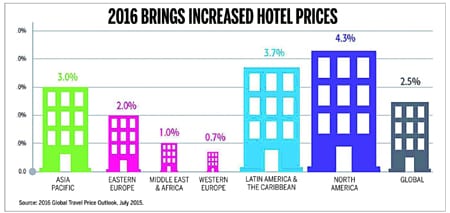CWT Meetings & Events report predicts industry growth in 2016
Caution raised to meeting and event planners about stricter booking conditions
CWT Meetings & Events has released its 2016 Meetings and Events Forecast which predicts positive growth for the industry in the coming 12 months. While the news of overall growth is positive, the report also sounds a note of caution. As attrition and cancellation terms are becoming stricter, supplier negotiations will be more important than ever to meeting planners. The fourth annual edition of forecast provides event planners with comprehensive regional data, including average attendee cost per day and average group size, so they can plan and budget for the coming year.
David Moran, executive vice president, Carlson Wagonlit Travel, said, “Our forecast is about providing clients with valuable insight for the coming year, so they armed with the most relevant information for their upcoming budgeting and negotiations. Whether they are focused on meetings, events or the widespread global adoption of strategic meetings management, it’s a vital tool in preparing for the year ahead.”
Key findings from different regions around the world include:
- The unpredictable economy in Asia Pacific could cause challenges in the region, although stronger demand from China and India could drive up group size and prices.
- High demand for meetings and events venues in North America is exceeding supply, resulting in a sellers’ market. Careful planning is therefore very important.
- Meanwhile, in Europe, buyers are gaining greater negotiating power as the region sees slow but steady growth.
- Pockets of high demand will be created around the Rio 2016 Olympics; and Paralympic Games next summer, resulting in a potential shortage of meeting space.
This year’s report also offers a range of practical tips for those planning meetings and events in 2016. Tips include:
- Plan ahead – be aware that some hotels in high-demand markets no longer hold space when responding to availability requests. Make internal decision makers aware, and decide if you can be flexible on dates.
- Fuel your budget as well as your attendees – food and beverage (F&B) continues to be a significant driver of per-attendee costs. Adjust F&B patterns to manage budgets while promoting the healthy alternatives that remain popular with attendees.
- Tick tock – lead time for registration and venue contracts continues to shrink. However, by increasing the lead time for larger events, event and meeting planners can increase their negotiation power.
M&E outlook
Hotel prices up globally in 2016
Globally, the M&E price outlook will be varied. Demand in North America, both transient and group, continues to grow at a rate that exceeds new supply, and the result is a seller’s market causing challenges for meeting owners. Europe is seeing slow but steady growth with buyers gaining greater leverage. In Asia and Latin America, economic challenges are causing uncertainty.
For meeting owners who seek to hold a meeting in a high-demand market where suppliers hold the control, there are a number of trends. Hotels are omitting or reducing flexibility in key clauses related to cancellation and attrition in both rooms and F&B, and they’ve limited rebooking for future dates or the ability to resell unneeded rooms. Attrition clauses are under significant pressure in compressed tier one markets. In these mega cities with large airport hubs, there are upfront offers in the 10-15 per cent range, compared to a traditional 20-25 per cent.
In addition, planners need to be aware that hotels in high-demand markets are beginning to stop holding space when responding to availability requests. Meeting owners should alert internal decision makers of this market shift, as the risk of lost space will increase and date flexibility will be crucial as events are sourced.
Asia Pacific
China and India dominate spend for the region
The unpredictable economy and health-related scares threaten to limit overall growth for the region. However, strong demand from China and India will drive prices and group size up, which should mitigate the challenges in the rest of Asia Pacific. Increased governance and focus on compliance is being driven by the pharmaceutical industry, prompting these companies to look for ways to gain the best control of their overall M&E programmes. As of June, there are 2,363 hotels offering 554,532 rooms under contract in the region, representing a 6.7 per cent increase compared to June 2014, and a 0.6 per cent year-over-year increase in rooms under construction. Indonesia and China are constructing a strong pipeline of hotels, with large global chains expanding even further into China. Overall, supply is growing in the region, which is helping to moderate the cost increases driven by growing demand.


